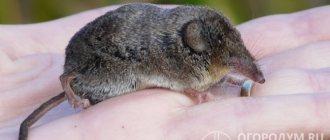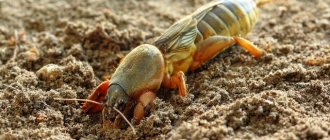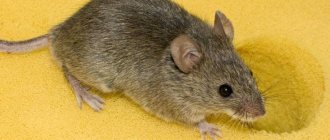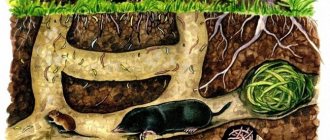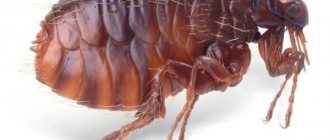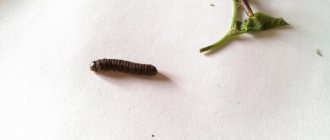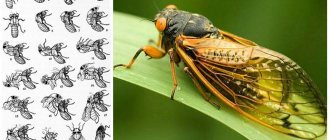Another pest that plagues gardeners is the shrew. Once there is an animal on the property, it can be quite difficult to get rid of it. Its presence can be seen by small mounds rising above the surface of the earth. It is believed that it is even useful. But gardeners have a completely different opinion. Why? This question and how to get rid of it on the site will be answered in the article.
What does a shrew eat?
Animals are omnivores; the main food is insects, their larvae, and earthworms. They do not disdain small frogs, lizards, and young small rodents. Food is found using smell and touch. Shrews are constantly looking for food. During the day they eat an amount of food that exceeds 2 or more times their own weight. They take short naps between meals. There are about 80 such cycles per day. Without food, shrews die within 7-9 hours, or fall into short-term torpor with a decrease in body temperature. They do not hibernate.
Reproduction of representatives of the shrew family
Mice that dig in the soil reproduce after surviving the winter. Pregnancy usually lasts about 2-3 weeks. In one litter, the female brings up to 5-6 cubs. The female hides her children in specially equipped burrows.
At the age of three weeks, the young leave the burrow and disperse throughout the territory. At this moment, the animals weigh only 5-6 grams. By autumn, their weight increases to 10 grams. Some members of the shrew family do not survive the winter, and the goal of the survivors is to survive the winter and reproduce the following spring. Females live longer than males by 1 month.
Benefits and harms
Due to their omnivorous nature, it is believed that shrews bring benefits by destroying soil insects and their larvae. Moreover, the process occurs all year round and in places that are difficult to reach for other insectivorous mammals: under snow, stones, trees, and in the depths of burrows.
Shrews emit a strong unpleasant odor, which causes some animals to leave them uneaten (foxes, domestic cats). However, this smell does not frighten owls, weasels and ferrets, who eat them without any disgust.
Despite the fact that the soil where the animals live becomes loose and enriched with oxygen, it is not suitable for growing any plants.
The nimble animals are constantly in search of food, so they have to constantly dig through the surface layer, breaking through peculiar tunnels. At the same time, shrews damage the root system of plants encountered along their path. The soil thrown to the surface becomes an obstacle for the fishing line on the trimmers. Having encountered such mounds of earth, it instantly breaks.
Habitat
What attracts attention to this animal is its very small size. For this reason, they are usually considered to be the smallest predators on the planet . People who have frequently encountered shrews are aware of their aggressive nature, which explains their nickname “little devil.” In total, the shrew genus includes approximately 300 species, which can be represented in two families:
- shrews (with white teeth);
- shrews (with dark-colored teeth).
Among the most common representatives of the family, the following species are worth highlighting:
- tiny shrew;
- dwarf shrew;
- water cutter, etc.
You can meet these miniature animals in almost any part of the globe , since they thrive in areas with different climates.
Their habitat is very diverse: shrews live in South America, Colombia, the USA, and Russia. You won't find them except in the polar regions and Australia.
In our country, this family is represented by 20 species. The most common of them is the shrew. The animal has a very small body, which can reach 3-18 cm in length.
How to distinguish a shrew from a mole
Externally, shrews are similar to moles. What is their difference?
The mole is usually larger than the shrew, its length is up to 15 cm, and it weighs more - up to 100-140 g. The tail is approximately 4 cm long. Its head is elongated, elongated with a proboscis, making it similar to a shrew. The body is covered with dark velvety fur. Moreover, the hairs of the fur grow straight, allowing the animal to move underground in any direction; the pile lies easily in different directions.
The mole's paws are flipper-shaped, turned outward, with long claws. This allows the mole to easily break through tunnels in the ground. With its hind paws it throws the earth out of the hole. The eyes and ears are small and covered with hair.
Shrew , unlike the mole, is a small animal, up to 5 cm. The tail can be much longer than the length of its body. The fur is soft, velvety gray, like that of house mice. Unlike a mole, its paws are small, with small claws, and covered with light hair. The eyes are small, barely noticeable.
They can be distinguished by the appearance of their minks. If moles have mounds rising above the surface - molehills. Shrews only have holes in the ground; more often they occupy previously dug passages in moles, mice, rats, and hamsters.
What kind of pest is this?
There is an opinion that the shrew can be confused with a field mouse. However, in practice this is quite difficult to do. Once you carefully examine the animal at least once, the analogy with voles will disappear forever.
The small body is covered with gray or gray-brown hair. Short legs. A long tail. These are all possible characteristics of similarity. There are much more differences. The shrew's skull is elongated and has a fairly large size in relation to the body. On the muzzle there is a characteristic “proboscis” - an elongated, slightly bent nose.
The size of the shrew depends on its age. A young individual can weigh literally a couple of grams and be no more than 3.5 cm long. Adults reach up to 150 g and 18 cm. The eyes are weak-sighted. The ears are small. In winter, body size decreases. The magical effect is caused by a high ability to adapt to circumstances - hibernation is excluded, and the amount of food is reduced.
Most often in the middle zone there are 2 types:
Dwarf shrew)
Gray-brown fur, sharp teeth, size about 7 cm. A distinctive feature is the drooping tail with pronounced villi.
Common shrew (forest)
Body length is about 5 cm, dark brown in color with light spots on the belly. Most common in dachas near forested areas.
The species also distinguishes the shrew from the mouse. The owner of the proboscis is not a rodent at all, but a mammal that eats insects.
Features of behavior
Shrews have little predictable behavior.
They suddenly appear on the site and can leave it forever for no apparent reason. It’s impossible to guess what exactly you liked or didn’t like about a particular area. Nevertheless, it was possible to notice the most common preferences.
Insectivorous animals like moist soil. It is easier to dig holes, build passages and make supplies in it. It is very difficult to create a deep labyrinth in hard ground.
Burrows are often found in regularly watered beds with dense vegetation, in grass near water bodies and in overgrown bushes.
Shrews are partial to greenhouses. If there is one or more on the site, the gardener should be prepared for raids - a couple of labyrinth passages will definitely be laid inside.
You can find a hole by deposits of branches, leaves, and locations of old settlements of moles, mice, mole rats, and rats. The animals do not hesitate to occupy empty “houses”, bravely defend their possessions and keep themselves apart from other animals. Usually it is the males who do the repelling. They use their musky scent to warn enemies. Only ferrets, owls and weasels do not respond to threats.
Shrews eat extremely quickly and a lot. They die from hunger for more than 7 hours, so every three hours they eat food according to their own body weight. This is the only way they can keep warm and maintain their metabolism during short sleep. The day is not divided into night and day time. The regime is designed to alternate between rest and hunting for beetles, larvae, worms, small frogs, and lizards.
Each summer period is accompanied by the appearance of at least 14 cubs from one female. Babies become independent at 4 weeks. Life expectancy is no more than one and a half years.
Expert opinion
Mityuk Stefania Bogdanovna
Sometimes shrews manifest themselves precisely during the period of breeding. On the site you can see trains of animals. This is how children follow their mother, holding each other’s tails.
It is easy to distinguish from rodents. The eaten crop is definitely not the work of shrews' teeth. They do not feed on root vegetables.
How to get rid of shrews in your country house (garden)
How to get rid of shrews on the site is a question that worries many gardeners. After all, when animals appear in a summer cottage or garden, they create many problems. Moreover, the animal is nimble, rarely appears on the surface, and it is quite difficult to fight it. Methods for getting rid of shrews are similar to fighting moles. Use
- chemical,
- physical,
- mechanical,
- folk methods.
Chemicals
Find shrew burrows. Pour odorous substances into it, such as mothballs, tobacco, or fill the minks with diesel fuel.
Other effective remedies are “Hunter Anti-Rodent”, “Nutcracker”, “Ekar”, “Rat Death”, which cause suffocation and death in the animal. Products are purchased in specialized stores. Before use, you must read the instructions; do not use them near trees and bushes.
Since chemicals are potent, when working with them, wear protective clothing, a respirator or a cotton-gauze mask, and gloves.
Ordinary baits for mice or rats are also used, which are placed near the burrows.
Physical methods
Deterrents are used, such as pinwheels with tin cans and beer cans. Dangling on a stick stuck in the ground, they create a vibration that causes discomfort in the ground for the animals, forcing them to leave.
Some gardeners use firecrackers, which they throw into a hole and immediately cover it with earth. The use of ultrasonic repellers has a certain effect.
Mechanical methods
By flooding the burrows with water from a hose, the animals can be driven out of their burrows. Of course, they will have to be guarded when they escape from there, and somehow destroyed. Or use mole traps and traps, placing them in holes.
Traditional methods
Domestic cats can help fight shrews. Some hunting cats can catch them in the heat of the hunt. But they won’t eat them - the animals have special glands that secrete a pungent and unpleasant odor. This is their only defense against other small predators.
Try planting marigolds in your area; shrews don’t like their smell. Also, the animals do not like beans, beans, peas, or spurge. Perhaps the plants will scare away the shrews.
Reviews from gardeners
Konstantin, 64 years old, Rostov
The simplest methods helped to scare away shrews from a summer cottage: acoustic and “aromatic”. Before the autumn digging of the garden, dried marigolds crushed into dust were scattered, and rags soaked in turpentine were buried along the entire border of the plot. Pieces of rotten fish were placed in the holes. In case the shrews bypassed the bait, additional metal reinforcement was dug into the garden bed at a slight angle to the ground, to a depth of 40-50 cm. A plastic bottle was placed on it, which moved with a light blow of wind, and the noise from the vibration of the steel rod scared away the animals. Champagne bottles, also at an angle, were buried in the ground - the effect was the same - an unbearable roar was heard.
Veronica, 56 years old, Ryazan region
In the garden plot we did not decide to use poison or traps for humane reasons, so we save ourselves from shrews using the Grad ultrasonic device. I insert batteries into the device, seal it in a plastic bag and dig it near the holes to a depth of 10 cm. After 2-3 weeks I observe the complete disappearance of the pest. At the same time, ultrasonic waves do not have a harmful effect on animals and people.
Semyon, 48 years old, Krasnodar region
In my apiary in mid-November, a shrew got into the habit of emptying the hives. It is more dangerous than ordinary mice because it is small and very voracious. To drive it away, I placed a fine-mesh (size 6 mm) grate between the bottom and the lower body, but the tight holes prevented the bees from exiting. In March I replaced it with a mesh with 8-10 mm cells. In addition, I cleaned the hives of dirt and placed a pollen collector on the entrance. After that, all the problems with pests disappeared.
Traditional methods
Means for expelling rodents from the site Over many years, summer residents and owners of country and suburban areas have tried various folk remedies for shrews:
- planting strong-smelling plants throughout the area (wormwood, mint, lentils, hazel grouse and legumes) or scattering substances with an unpleasant odor near burrows (mothballs, kerosene, rotten fish);
- A fairly simple way is to pour water into the discovered holes from a hose or a 10-liter bucket, as well as kerosene or diesel fuel;
- using gas bombs, smoke bombs or poisonous gas - pests will flee;
- the use of reagents with a strong odor: Pomethanol, Ekara, Creatol, etc., however, this method is not recommended for use near fruit trees;
- installation of mechanical repellers with a sharp sound, made by yourself: tin pinwheels, cut plastic bottles on a stick up to 1 m high; when there are gusts of wind, they make sounds that pests are afraid of, which will force them to leave the territory;
- use of ultrasonic repellers;
- to protect against the penetration of shrews from neighbors, they dig in sheets of iron or slate along the perimeter of the site to a depth of 1-1.5 m;
- planting onions and garlic between the beds in the garden plot, the aroma of which cannot be tolerated by such pests;
- You can place a bunch of hemp inside the hole: it begins to rot and emit a characteristic smell that will force the animals to leave the area.
Important!
If a shrew accidentally runs inside the house, then there is no need to touch it. After some time, she will break free on her own, because... they do not live indoors.
Despite all of the above methods of dealing with shrews, after a while, if protective noise and other measures are not taken, they may come to visit again, which will become noticeable by the appearance of piles of dug up earth in the middle of the garden, lawn and exposed plant roots.
